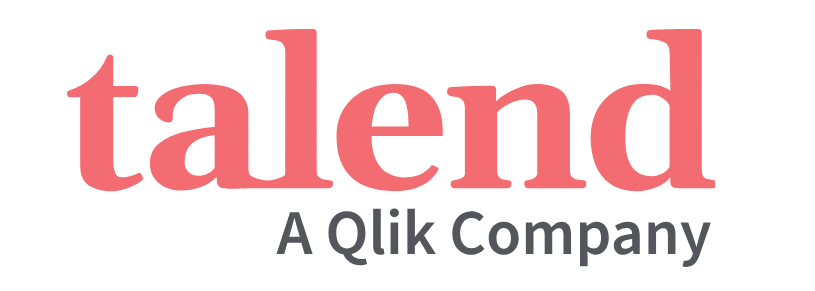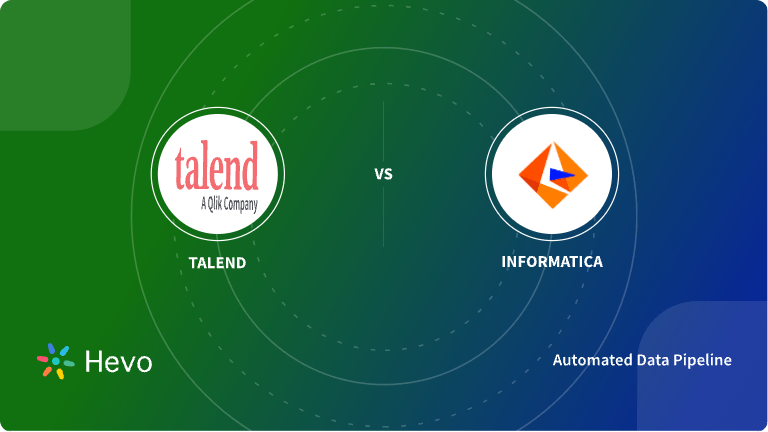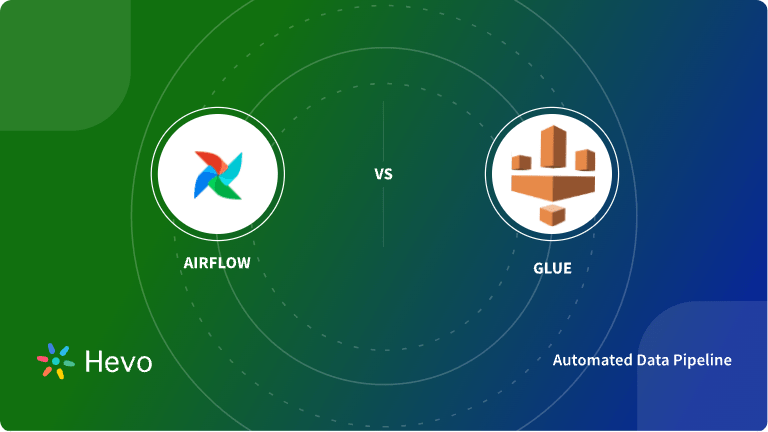Choosing the right data integration tool is crucial for managing workflows and ensuring your data pipelines are efficient and reliable. Talend and Airflow are two powerful tools in this space, each with strengths and limitations. In this blog, we’ll explore what each tool offers, compare Talend vs Airflow, and explore whether an even better option, like Hevo, is available.
Table of Contents
Talend Overview

G2 Rating: 4.3(46)
Capterra Rating: 4.6(14)
Talend is a comprehensive data integration tool with a wide range of features that are suitable for both small businesses and large enterprises. It’s known for its user-friendly interface and robust capabilities, especially in ETL (Extract, Transform, Load) processes.
Key Features
- User-Friendly Interface: Talend offers a drag-and-drop interface that makes it easy to design and manage data integration processes.
- Extensive Connectors: With over 1000 pre-built connectors, Talend allows you to connect to virtually any data source, be it databases, cloud services, or applications.
- Real-Time Data Processing: Talend enables real-time data processing, which is essential for applications that require immediate insights.
- Data Quality and Governance: Built-in tools for data cleansing, profiling, and governance ensure that the data you’re working with is accurate and compliant with regulations.
- Scalability: Talend scales from small projects to enterprise-level deployments, supporting both on-premises and cloud environments.
Pricing
Talend offers several pricing plans, including the Data Management Platform, Big Data Platform, and Data Fabric. Specific pricing details are not publicly available and require direct contact with Talend’s sales team. Their pricing model is subscription-based, with options for different levels of functionality.
Talend’s pricing can be higher, especially for large enterprises that require extensive functionality and support.
Use Cases of Talend
- Talend is well-suited for businesses of all sizes that require a flexible, user-friendly, and scalable data integration tool.
- Its model makes it an attractive option for organizations that need a customizable solution without the overhead of expensive licensing fees.
Airflow Overview

G2 Rating: 4.3(86)
Capterra Rating: 4.6(10)
Apache Airflow is an open-source workflow automation tool that orchestrates complex data pipelines. It’s highly flexible and ideal for organizations that need to manage a wide variety of workflows and data-processing tasks.
Key Features
- Dynamic Pipeline Generation: Airflow allows you to define workflows as code, which gives you the flexibility to create complex, dynamic pipelines.
- Scalability: Airflow is designed to scale with your needs, from small, single-machine setups to large, distributed environments.
- Extensibility: Airflow’s plugin architecture allows for easy extension to include custom operators, sensors, and more.
- Scheduling and Monitoring: Airflow’s built-in scheduler and monitoring tools make automating and monitoring your workflows easy.
- Open Source Community: Airflow is open source, So It benefits from a large and active community that contributes to its continuous improvement and provides extensive documentation and support.
Pricing
Since Airflow is an open-source tool, it’s free to use. However, there are costs associated with setting up and maintaining the infrastructure needed to run Airflow, especially if you’re deploying it at scale. Costs can include:
- Infrastructure Costs: Depending on where you deploy Airflow (on-premises or in the cloud), you’ll need to budget for servers, storage, and other infrastructure.
- Operational Costs: Managing and maintaining an Airflow deployment requires technical expertise, which can increase overall costs.
- Support Costs: While the community is a great resource, you might need to invest in dedicated support if your organization requires it.
Use Cases of Airflow
- Airflow is ideal for organizations with complex data pipelines involving multiple steps, dependencies, and scheduling requirements.
- Airflow’s Python-based architecture allows for high customization and integration with various tools and technologies, making it a great choice for businesses that need a tailored solution.
Head-to-Head Comparison
| Feature | Talend | Airflow |
| Ease of Use | Drag-and-drop interface | Code-based, requires Python |
| Focus | Data integration and management tasks. | Workflow management and orchestration. |
| Connectors | 1000+ pre-built connectors | Limited but extensible |
| Real-Time Processing | Yes | Limited |
| Data Quality Tools | Extensive | Basic |
| Scalability | High | High |
| Cost | Subscription-based | Free, with infrastructure costs |
| Community Support | Smaller, but dedicated | Large and active |
| Security Certifications | GDPR, SOC2, HIPAA, CSA STAR | Not available |
| Customization | Moderate | High |
| Deployment Options | On-premises, Cloud | On-premises, Cloud |
| Pricing | Custom pricing for each of the Talend suite products. | Free |
Hevo distinguishes itself in the data integration landscape with its exceptional features and user-centric approach. Unlike Fivetran and Airflow, Hevo offers:
- Competitive Pricing: Benefit from Hevo’s cost-effective solutions, providing high-quality data integration at a more affordable price.
- Custom Transformations: Hevo’s robust transformation capabilities allow you to tailor data workflows precisely to your needs.
Join over 2000+ satisfied customers, including ThoughtSpot, who rely on Hevo for their data integration needs. Don’t just take our word for it; see why we are rated 4.3 on G2.
Get Started with Hevo for FreeWhich Should You Choose?
When deciding between Talend and Airflow, consider the specific needs of your project or organization:
- Choose Talend if:
- You prefer a user-friendly, drag-and-drop interface.
- You need extensive out-of-the-box connectors.
- Data quality and governance are top priorities for your organization.
- You’re looking for a comprehensive, all-in-one solution for data integration.
- Choose Airflow if:
- You have the technical expertise to manage a code-based workflow tool.
- You need to orchestrate complex, dynamic pipelines.
- You’re working in a highly scalable environment and need a tool that can grow with your needs.
- Open-source flexibility and community support are important to you.
Pros and Cons of Airflow vs Talend
- Airflow
| Pros of Airflow | Cons of Airflow |
| – High-Performance – Fault-Tolerant – Multi-Language Support – Secure and Scalable – Open-Source | – No managing and monitoring tools – Lack of message paradigms – Message Tweaking issue |
- Talend
| Pros of Talend | Cons of Talend |
| – Easily scalable – Efficient management – Drag-and-drop | – Performance limitations, for large datasets – Expensive |
Is There Something Better in the Market?
If you’re looking for a tool that overcomes the limitations of Talend and Airflow, Hevo might be the solution you need. Hevo is a no-code data pipeline platform that allows you to move data in real-time with minimal setup.
- Ease of Use: Hevo’s no-code interface is even more user-friendly than Talend’s, making it accessible to non-technical users.
- Real-Time Data Processing: Like Talend, Hevo offers real-time data processing but with a simpler setup process.
- Automatic Schema Mapping: Hevo automatically detects the schema of your incoming data and maps it to the destination, reducing manual work.
- Extensive Integrations: Hevo offers 150+ pre-built integrations, which, while fewer than Talend, are more than enough for most use cases.
- Cost-Efficiency: Hevo’s pricing is competitive, and since it’s fully managed, you don’t need to worry about infrastructure costs.
Hevo combines the best of both worlds—Talend’s ease of use and Airflow’s flexibility—without their respective downsides.
Conclusion
Both Talend and Airflow are powerful tools, but they cater to different needs. Talend is ideal for organizations that need a user-friendly, all-in-one solution with strong data governance features, while Airflow is perfect for those who require the flexibility to manage complex, code-based workflows. However, if you’re looking for something that combines both strengths while minimizing their weaknesses, Hevo is worth considering.
No matter which tool you choose, the key is to align it with your specific needs, whether that’s ease of use, flexibility, or cost-efficiency. In the ever-evolving world of data integration, staying informed about the latest tools and trends will help you make the best decision for your organization. Schedule a personalized demo with us for free.
FAQ on Talend vs Airflow
Is Talend free to use?
Talend used to offer a free, open-source version called Talend Open Studio, but it has now been acquired by Qlik and no longer provides a free version.
Can I use Airflow for real-time data processing?
Airflow is primarily designed for batch processing, and while it can handle real-time tasks, it’s not as optimized for them as Talend or Hevo.
What makes Hevo different from Talend and Airflow?
Hevo offers a no-code interface with real-time data processing, making it easier to use than both Talend and Airflow while still providing robust features.
Which tool is better for small businesses?
Due to its ease of use and cost efficiency, Hevo might be the best option for small businesses with limited technical expertise.
Do I need to know Python to use Airflow?
Yes, Airflow requires Python knowledge since workflows are defined as code.






